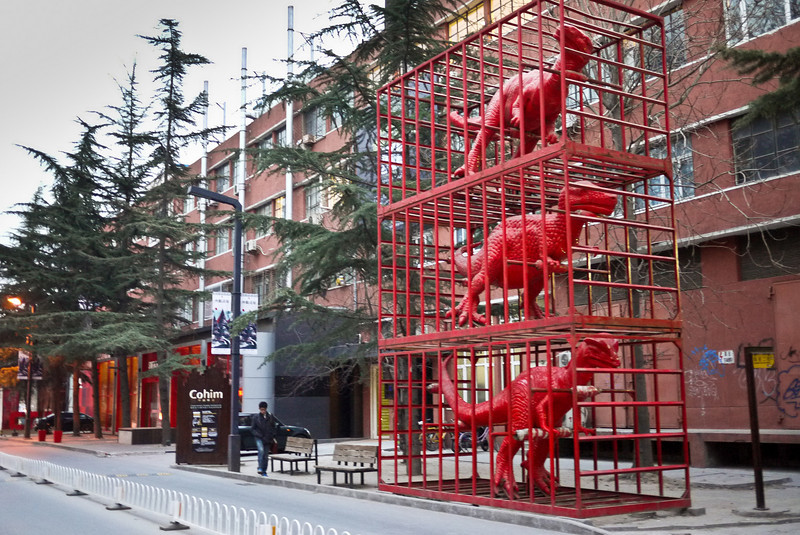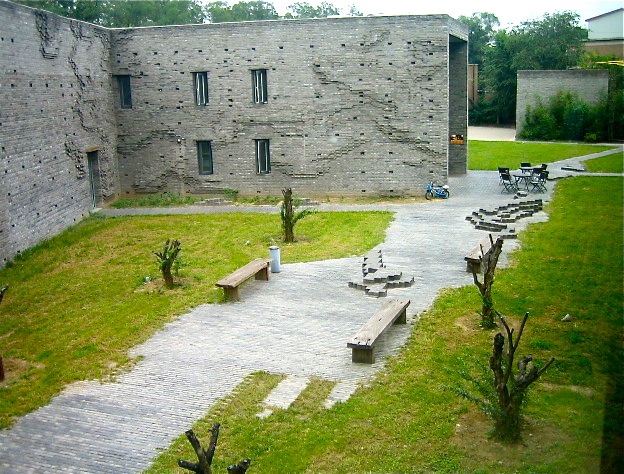Art World
Beijing’s Caochangdi Village Mixes First-Rate Art and Live Poultry
Get the scoop on Beijing's new, explosive contemporary art scene.

Get the scoop on Beijing's new, explosive contemporary art scene.

Christian Viveros-Fauné


Caochangdi.
Courtesy chinaculturedesk.com
San Francisco must have looked like this during the 1850s—dingy, brown, chaotic, and bustling with rude energy. After 25 years of unimpeded economic growth, Beijing is the perfect picture of a modern-day boomtown. This is a fever dream of a city complete with gleaming imported cars and toxic air Western architects have taken to calling “the Beijing blur.”
Nowhere is this gold rush more evident than in the neighborhoods that are home to the Chinese capital’s explosive contemporary art scene. Despite recent reports of weakness, evidence of ruddy health abounds. There may be a clampdown on excessive spending in China and a general slowdown in real estate prices, but there’s little arguing with an $8.5 billion yearly art business—according to the 2013 Global Chinese Art Auction Market Report produced by artnet and the China Association of Auctioneers—or with the frenzy this kind of bullish trade can unleash on a lively cultural landscape.
Like China’s capital—which shifts dizzyingly between traditional hutongs, squalid cement block housing and clusters of malls, hotels and luxury apartments—Beijing’s art scene has also transformed various areas of the city into vibrant neighborhoods to rival New York’s Chelsea, London’s Shoreditch and Berlin’s Mitte. The most prominent of these are Caochangdi and the 798 Arts District. The brief history of the first, predictably, hinges on the recent creative rise and relative stagnation of the second.
Located in Beijing’s northeastern Chaoyang District, close to where the Fifth Ring Road meets the Airport Expressway, 798 began as a Bauhaus-inspired compound of electronics and munitions factories built by East German architects in the 1950s. In 1995, long after the area was decommissioned, the complex was partly occupied by Beijing’s Central Academy of Fine Arts (BCCA). In the early 2000s, early adopters like Sui Jianguo, the head of BCCA’s department of sculpture, and Texan Robert Bernell, owner and publisher of Timezone 8 Art Books, set up shop there, setting off a now familiar chain reaction. High-end galleries, design shops, and fancy bars and restaurants followed—like touristy summer stalks pioneering spring.

Entrance to the UCCA.
798, or the Dashanzi Arts District, as it’s also called, is currently home to several arts institutions, among them the celebrated Ullens Center for Contemporary Art (UCCA)—closed during my visit in preparation for a show of paintings by American collector and restaurateur Michael Chow—as well as first tier galleries like Long March, Pace and Galleria Continua. Recently, the former hosted a show of large cast metal piles by sculptor Zhan Wang (the sculptures mostly resemble extruded plastic), while the last two held a joint group exhibition (together with the Tang Contemporary Art Center). Titled “Unlived By What Is Seen,” the show promises to trace “a new direction in Chinese contemporary art” through “the infiltration of art practices into various social sectors and aspects of life.” Alas, the exhibition has nothing to do with Western “social practice”—a tall order in totalitarian China. Instead, the many video and photo-based works on view oddly document insignificant aspects of artists’ lives (daily regimens, incidental conversations, one artist’s cat fancying) leaving the essence of conceptualism as “idea art” largely lost in translation.
Thankfully, much stronger art is on view just a few miles away in Caochangdi, the art village designed by Ai Weiwei as a response to the increasingly commercial aspect of the 798 Arts District. A warren-like maze of two and three-story buildings in gray brick, Caochangdi is home to Ai’s FAKE studio—the entrance is presently the object of a dozen government surveillance cameras—as well as an important number of galleries, homes and studios that have turned this once quaint farmer’s village on the outskirts of Beijing into “the spiritual promised land for Chinese contemporary art,” according to China’s leading newspaper, The People’s Daily.
A mix of artist complex and rural hamlet, Caochangdi features first-rate art exhibitions alongside live poultry and vegetable markets. Among the art spaces I managed to visit were Ink Studio, Taikang Space and the ARTMIA Foundation. The first currently features a fantastic exhibition of large ink on paper abstractions by Li Huasheng, whose work was featured prominently in the Met’s 2013 show “Ink Art: Past and Present In Contemporary China.” Once a prominent landscape painter in the traditional manner, the 71 year-old Li suffered a creative crisis in 1997 that left him unable to work for a year. Eventually, after time spent in Tibetan monasteries in the Himalayas, the artist opted for ink-based grids and all-over patterns similar to Western abstraction—but with a twist. Works that alternately resemble paintings by Agnes Martin or Brice Marden, the veteran artist’s panels provide evidence of exquisite improvisation and control.
Around the corner, at Taikang Space, Liu Chang’s installation of pulp romance novels meticulously redraws the books’ marginalia onto the gallery’s walls—the better to document the voiceless aspirations of thousands of young women who once rented these books after laboring long hours in anonymous sweatshops (the artist claims since 2010 these books are largely downloaded onto phones, basically muffling their commentary). Elsewhere, at the ARTMIA Foundation, a group exhibition of painting, sculpture and video titled “Landscape of the Mind” hints at both the strength of tradition in China and the huge, anonymous forces that assail its rapidly changing present. While the resolutely realistic painted urban landscapes of Zhou Dong describe the brackish sprawl of Beijing in profusely impastoed detail, Yi Lan’s haunting single channel river-based video “Undercurrent” captures the strange dream-like state that envelops the day-to-day of China’s capital—at least as seen through the eyes of a first time visitor.